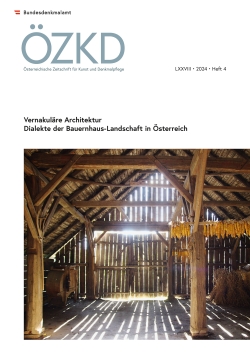
ÖZKD LXXVIII 2024 Heft 4, pp. 78-86, 2025/02/12
Vernakuläre Architektur
Dialekte der Bauernhaus-Landschaft in Österreich

Although building construction using wood has increased throughout Austria in recent years, this traditional construction material had to contend with image problems during much of the twentieth century. During the interwar period, construction techniques using wood began to be modernized in a way that was promising—by using prefabricated components, for example—but this trend came to a halt with the rise of the Nazi regime. For many decades, this almost put a stop to the century-long tradition of making buildings out of wood and kept that tradition from being transformed using contemporary designs. Starting from the western province of Vorarlberg, buildings come to mind that were designed by a few architects who resumed the use of wood as a building material after 1945—as a connection of old and new that avoids kitsch; as wooden cases that radiate comfort; and as a new path in wooden construction that makes a virtue of necessity.